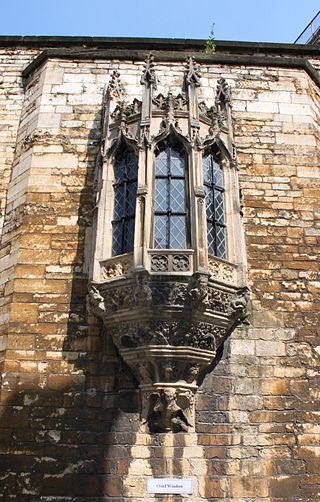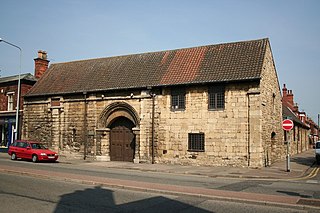
Lincoln is a cathedral city and district in Lincolnshire, England, of which it is the county town. In the 2021 Census, the city's district had a population of 103,813. The 2021 census gave the urban area of Lincoln, including Bracebridge Heath, North Hykeham and Waddington, a recorded population of 127,540.

The Foss Dyke, or Fossdyke, connects the River Trent at Torksey to Lincoln, the county town of Lincolnshire, and may be the oldest canal in England that is still in use. It is usually thought to have been built around AD 120 by the Romans, but there is no consensus among authors. It was refurbished in 1121, during the reign of King Henry I, and responsibility for its maintenance was transferred to the city of Lincoln by King James I. Improvements made in 1671 included a navigable sluice or lock at Torksey, and warehousing and wharves were built at Brayford Pool in the centre of Lincoln.

Ancaster is a village and civil parish in the South Kesteven district of Lincolnshire, England, on the site of a Roman town. The population of the civil parish was 1,317 at the 2001 census, increasing to 1,647 at the 2011 census. The civil parish includes the settlements of Sudbrook and West Willoughby.

Hugh Segar "Sam" Scorer FRIBA FRSA was an English architect who worked in Lincoln, England and was a leading pioneer in the development of hyperbolic paraboloid roof structures using concrete. He also was involved in architectural conservation and research into the work of local 19th-century architects, as well as founding an art gallery in Lincoln, now known as the Sam Scorer Gallery. He held the rare distinction of having two of his buildings listed within his lifetime.

William Adams Nicholson was an English architect who worked in Lincoln and was a founding member of the Royal Institute of British Architects.

St Mary le Wigford is a Grade I listed parish church in Lincoln, in the county of Lincolnshire, England.

St Peter at Gowts is a Grade I listed parish church in Lincoln, Lincolnshire, England.

There are 48 Grade I listed buildings in Greater Manchester, England. In the United Kingdom, the term listed building refers to a building or other structure officially designated as being of special architectural, historical or cultural significance; Grade I structures are those considered to be "buildings of exceptional interest". In England, the authority for listing under the Planning Act 1990 rests with Historic England, a non-departmental public body sponsored by the Department for Culture, Media and Sport.

The City of Lincoln Council is the local authority for the district of Lincoln, in the county of Lincolnshire, England. The council consists of 33 councillors, three for each of the 11 wards in the city. It is currently controlled by the Labour Party, led by Naomi Tweddle. The administrative headquarters is at Lincoln City Hall although council meetings are held at the guildhall.

John of Gaunt's Palace was a late 14th-century merchant's house which stood in the lower part of Lincoln High Street, opposite the St Mary Guildhall. It was progressively demolished from the late 18th century until the 1960s. The very fine oriel window from the building has been preserved in the gatehouse of Lincoln Castle.

The Guildhall and Stonebow, Lincoln, has been the meeting place of Lincoln City Council from Medieval times to the present. The term Stonebow, which is derived from the Danish word stennibogi, indicates a stone archway that visitors entering the city from the south, along the High Street, would have passed through. It is a Grade I listed building. Lincoln City Hall, a 20th-century building on Orchard Street, provides further accommodation for the city council.

William Haywood was an architect who worked in Lincoln, England. His father John who died in 1817 was mayor of Lincoln twice and worked as a mason. Haywood succeeded his father as mayor after his death in 1817. His grandfather, John Hayward (1708–78) was also a mason in Lincoln. William Hayward's great grandfather was Abraham Haywood an architect of Whitchurch, Shropshire who came to Lincoln around 1720. William Haywood succeeded William Lumby as Surveyor to Lincoln Cathedral in 1799 and Edward James Willson followed him in this position in 1823. William Hayward also succeeded William Lumby as Surveyor for the Lincolnshire County County Committee, which had responsibility for Lincoln Castle and the prison. Howard Colvin considered Hayward to be a competent designer in the ‘Regency’ style and that from the re-construction of Kirton in Holland church in 1804 had an understanding of Gothic architecture quite remarkable at that date. Hayward also rebuilt the tower of Wrangle church in a similar style in 1820.

St Mary's Guildhall is a major domestic complex, indicating the highest social status, built in the part of the medieval city of Lincoln, England, known as Wigford. The Guildhall faces directly onto Lincoln High Street and stands to the north of Sibthorp Street. To the south is the late Saxon church of St Peter at Gowts. Stocker describes it as "the only survivor from the small group of the king's town houses which existed in several major towns….St Mary's Guildhall is a domestic complex on a palatial scale, indicating the highest social status, and as such is representative of a little known urban building type".

St Benedict's Church, Lincoln is an ancient church in Lincoln, England which is mentioned in 1107 and before the English Civil War was the Lincoln civic church. It was extensively destroyed in the Civil War, and was only partially restored. The tower was re-built imitating the other late Anglo-Saxon towers in Lincoln. All that survives is the present nave, which was the chancel of the former church and the chapel to the north built by Robert Tattershall in 1378.

The following is a timeline of the history of the city of Lincoln, the county town of Lincolnshire in the East Midlands of England.

City Hall is a municipal structure on Beaumont Fee, Lincoln, Lincolnshire, England. The structure is currently used as the headquarters of the City of Lincoln Council.

Central Methodist Church, Lincoln is a Grade II listed Methodist church in the city of Lincoln in Lincolnshire, England. It is an active place of worship in the Boultham area of the city near St Peter at Gowts church. It is one of the most unique listed buildings in Lincoln.

Lincoln City Centre is the historical and cultural area of Lincoln in Lincolnshire, England. It is defined as the areas along the city's High Street. Each part of the centre brings a differing main sector or sectors to the city with a small overlap between each area.
There are 588 scheduled monuments in the county of Lincolnshire, England. These protected sites date in some cases from the Neolithic period, and include barrows, artillery forts, ruined abbeys, castles, and Iron Age hill forts. In the United Kingdom, the scheduling of monuments was first initiated to ensure the preservation of "nationally important" archaeological sites and historic buildings. Protection is given to scheduled monuments under the Ancient Monuments and Archaeological Areas Act 1979.

Wigford is an inner-city suburb and historic district of Lincoln in the county of Lincolnshire, England. It is located to the south of the city centre and incorporates parts of the Cornhill Quarter and the High Street. It is also home to the oldest active parish church of St Mary le Wigford, as well as Lincoln railway station.


































